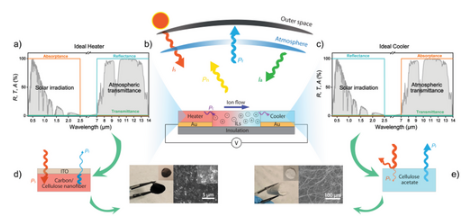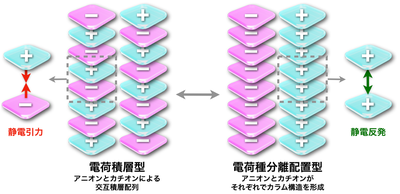2023-02-02 スウェーデン・リンショーピング大学
◆受動放射冷却とは、熱エネルギーが赤外線放射という形で物体から離れることを利用することで、木や建物、水、そして人間など、あらゆる物体は赤外線として熱を発しています。
◆大気は赤外線の波長域を透過する性質があるため、約-270℃の宇宙空間の冷たさを利用して、地球上の物体の熱を奪うことができるのです。温度差の結果として、正味の輸送が可能になります。したがって、受動的放射冷却の助けを借りて、物体は周囲温度よりも低い温度を得ることができる。
◆この効果は、はるか昔から、温暖な気候で氷を作るために使われてきた。しかし、近年、材料科学の研究により、この現象に注目が集まり、太陽の光で温められないで赤外線を放出する能力の高い新材料が開発されている。
◆リンショーピン大学の研究者たちは、このたび、受動的放射冷却によって熱を放出する程度を電気的に調整することで、デバイスの温度を調節できることを示しました。このコンセプトは、導電性ポリマーを用いて、デバイスの放射率を電気化学的に調整するものです。この成果は、学術誌『Cell Reports Physical Science』に掲載されました。
◆”サーモスタット “に例えることができます。現在、私たちが調整できる温度は0.25度です。大したことではないと思われるかもしれませんが、重要なのは、室温と常圧でこの調整が可能であることを示したことです」と、リンショーピン大学の主任研究員でこの研究の主執筆者のDebashree Banerjeeは言う。
◆研究者らは、今回、その可能性が示されたことで、材料とデバイスの両方をさらに開発できる可能性があると見ている。長期的には、太陽電池のように屋根の上に設置し、家屋からの赤外線熱放射を制御して必要なときに冷房を行うシステムを想定することができる。エネルギー消費が極めて少なく、公害も少ない方法です。このほかにも、衣服や壁紙などの熱の流れを調整し、エネルギー消費を抑えながら室内の快適性を向上させるなど、さまざまな応用が考えられます。
◆Advanced Science誌に掲載された別の研究では、同じ研究グループが、放射冷却の原理と太陽熱で補完される原理を利用した熱電デバイスを開発しました。このデバイスは、2つのセルロース材料の間に温度差を発生させることに基づいており、一方の材料には太陽の熱を吸収するためのカーボンブラックが含まれています。この素材は、温度差を電位に変換する素材に接続されています。この装置を空に晒すと、適度な日射量ですでに60mVの電圧が発生しましたが、2つの木質系素材は熱を放射する能力が異なるように設計されているため、このコンセプトは夜間でも有効です。
◆どちらの研究でも、制御された測定を行うために、研究者たちはスカイシミュレーターを作りました。こうすることで、屋外での測定と同じように、環境の変化による影響を受けずに測定ができるようになったのです。スカイシミュレーターは、放射線を反射するアルミニウムでコーティングされた側面があるチューブで構成されています。底に置かれた容器には、熱放射を吸収する物質が入っており、宇宙空間の寒さを再現するために液体窒素で冷やされています。
<関連情報>
- https://liu.se/en/news-item/passiv-utstralande-kylning-kan-styras-elektriskt
- https://www.sciencedirect.com/science/article/pii/S2666386423000334?via%3Dihub
- https://onlinelibrary.wiley.com/doi/10.1002/advs.202206510
環境下での放射冷却の電気的チューニング Electrical tuning of radiative cooling at ambient conditions
Debashree Banerjee, Tomas Hallberg, Shangzhi Chen, Chaoyang Kuang, Mingna Liao, Hans Kariis, Magnus P. Jonsson
Cell Reports Physical Science Published: February 1, 2023
DOI:https://doi.org/10.1016/j.xcrp.2023.101274

Highlights
- •Conducting polymer-based redox tuning of emissivity and radiative cooling
- •Control of device temperatures by thermal emissivity tuning
- •Night sky simulator for stable radiative cooling temperature measurements
Summary
Passive radiative cooling forms a sustainable means for cooling of objects through thermal radiation. Along with progress on static cooling systems, there is an emerging need for dynamic control to enable thermoregulation. Here, we demonstrate temperature regulation of devices at ambient pressure and temperature by electrically tuning their radiative cooling power. Our concept exploits the possibility to electrochemically tune the thermal emissivity and thereby cooling power of a conducting polymer, which enabled reversible control of device temperatures of around 0.25°C at ambient conditions in a sky simulator. Besides tuneable radiative cooling by exposure to the sky, the concept could also contribute to reduced needs for indoor climate control by enabling dynamic control of thermal energy flows between indoor objects, such as between people and walls.
セルロースを用いた放射冷却と太陽熱利用でイオン熱電変換を実現 Cellulose-Based Radiative Cooling and Solar Heating Powers Ionic Thermoelectrics
Mingna Liao, Debashree Banerjee, Tomas Hallberg, Christina Åkerlind, Md Mehebub Alam, Qilun Zhang, Hans Kariis, Dan Zhao, Magnus P. Jonsson
Advanced Science Published: 16 January 2023
DOI:https://doi.org/10.1002/advs.202206510

Abstract
Cellulose opens for sustainable materials suitable for radiative cooling thanks to inherent high thermal emissivity combined with low solar absorptance. When desired, solar absorptance can be introduced by additives such as carbon black. However, such materials still shows high thermal emissivity and therefore performs radiative cooling that counteracts the heating process if exposed to the sky. Here, this is addressed by a cellulose-carbon black composite with low mid-infrared (MIR) emissivity and corresponding suppressed radiative cooling thanks to a transparent IR-reflecting indium tin oxide coating. The resulting solar heater provides opposite optical properties in both the solar and thermal ranges compared to the cooler material in the form of solar-reflecting electrospun cellulose. Owing to these differences, exposing the two materials to the sky generated spontaneous temperature differences, as used to power an ionic thermoelectric device in both daytime and nighttime. The study characterizes these effects in detail using solar and sky simulators and through outdoor measurements. Using the concept to power ionic thermoelectric devices shows thermovoltages of >60 mV and 10 °C temperature differences already at moderate solar irradiance of ≈400 W m−2.



